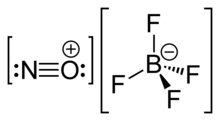Nitrosonium tetrafluoroborate
Nitrosonium tetrafluoroborate, also called nitrosyl tetrafluoroborate, is a chemical compound with the chemical formula NOBF4. This colourless solid is used in organic synthesis as a nitrosating agent.[1]
 | |
| Names | |
|---|---|
| IUPAC name
nitrosonium tetrafluoroborate | |
| Other names
nitrosyl tetrafluoroborate | |
| Identifiers | |
CAS Number |
|
3D model (JSmol) |
|
| ChemSpider | |
| ECHA InfoCard | 100.035.148 |
PubChem CID |
|
| UNII | |
InChI
| |
SMILES
| |
| Properties | |
Chemical formula |
BF4NO |
| Molar mass | 116.81 g·mol−1 |
| Appearance | colourless crystalline solid |
| Density | 2.185 g cm−3 |
| Melting point | 250 °C (482 °F; 523 K) (sublimes) |
Solubility in water |
decomposes |
Except where otherwise noted, data are given for materials in their standard state (at 25 °C [77 °F], 100 kPa). | |
| Infobox references | |
NOBF4 is the nitrosonium salt of fluoroboric acid, and is composed of a nitrosonium cation, [NO]+, and a tetrafluoroborate anion, [BF4]−.
Reactions
The dominant property of NOBF4 is the oxidizing power and electrophilic character of the nitrosonium cation. It forms colored charge transfer complexes with hexamethylbenzene and with 18-crown-6. The latter, a deep yellow species, provides a means to dissolve NOBF4 in dichloromethane.[2]
Nitrosonium tetrafluoroborate may be used to prepare metal salts of the type [MII(CH3CN)x][BF4]2 (M = Cr, Mn, Fe, Co, Ni, Cu). The nitrosonium cation acts as the oxidizer, itself being reduced to nitric oxide gas:[3]
- M + 2NOBF4 + xCH3CN → [M(CH3CN)x](BF4)2 + 2NO
With ferrocene the ferrocenium tetrafluoroborate is formed.[4]
References
- "A15806 Nitrosonium tetrafluoroborate, 98%". Alfa Aesar website. Retrieved 2010-09-04.
- Lee, K. Y.; Kuchynka, D. J.; Kochi, Jay K. (1990). "Redox equilibria of the nitrosonium cation and of its nonbonded complexes". Inorganic Chemistry. 29 (21): 4196–4204. doi:10.1021/ic00346a008.
- Heintz, Robert A.; Smith, Jennifer A.; Szalay, Paul S.; Weisgerber, Amy; Dunbar, Kim R. (August 2004). "11. Homoleptic Transition Metal Acetonitrile Cations with Tetrafluoroborate or Trifluoromethanesulfonate Anions". Inorg. Synth. 33: 75–83. doi:10.1002/0471224502.ch2. ISBN 978-0-471-46075-6.
- Roger M. Nielson; George E. McManis; Lance K. Safford; Michael J. Weaver (1989). "Solvent and electrolyte effects on the kinetics of ferrocenium-ferrocene self-exchange. A reevaluation". J. Phys. Chem. 93 (5): 2152. doi:10.1021/j100342a086.